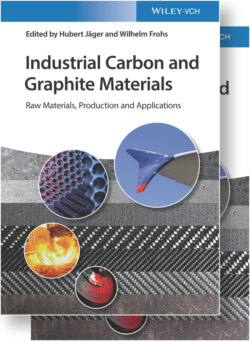Читать книгу Industrial Carbon and Graphite Materials - Группа авторов - Страница 276
6.1.2.3. Production
ОглавлениеIn 2004, about 60 × 106 t/a of petroleum coke were produced worldwide. The production rate is increasing from 110 × 106 t/a in 2013 and is estimated to reach 150 × 106 t/a in 2017. The main reason for the increase in petroleum coke production are the projects that started in 2005, to refine Orinoco crudes [4] (largest petroleum reserve in the world) and Athabasca oil sands [5]. Both are heavy crudes with a high coke yield. About three quarters of the worldwide petroleum coke production is available on the market. One quarter will be reused by the producer [6, 7]. The available petroleum coke in market is about 10% of the quantity of blast furnace coke (hard coke), produced from hard coal [8]. More than 92% of the petroleum coke is produced in delayed cokers; about one third of the feed streams is incurred as petroleum coke. Residues and crack components (see Section 6.1.2.3.1.1) are used in delayed cokers in more than one hundred refineries. Due to the reaction conditions, net coke production from fluid cokers and flexicokers is only about 5–10 wt% of the feed material. The number of these production units is much lower. As of 2013, about 15 fluid cokers and 7 flexicokers were in production worldwide. About 20–25% of 700 refineries worldwide are equipped with delayed cokers. The number of delayed coker units is more than 150 worldwide. From the 140 US refineries in operation, 55 have delayed coker units. Most of the petroleum coke is produced in the United States, followed by China, South America, Canada, India, Middle East, and Western Europe.
Anode‐grade calcined petroleum coke is the more important product with regard to margin and value. In 2014 this production rate was 29 × 10 t/a.
Table 6.1.2.1 and Figure 6.1.2.1 list the worldwide locations for petroleum coke production, the area production rates for petroleum coke, and the progress of delayed coker projects in different areas [6, 7, 9, 10].
